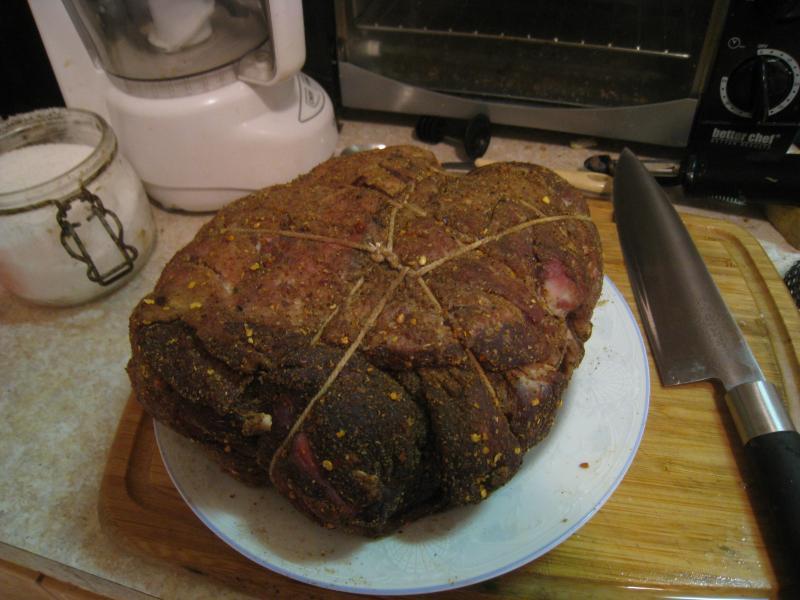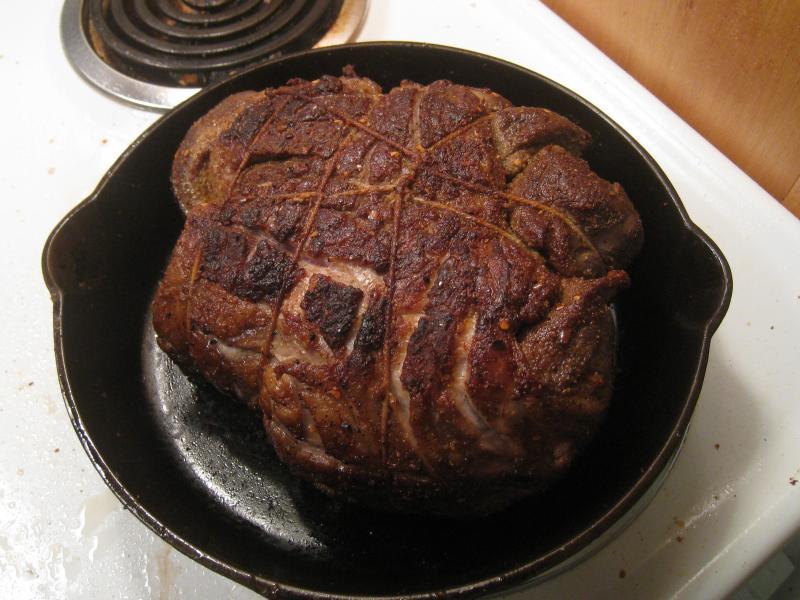-
Posts
3,850 -
Joined
-
Last visited
Content Type
Profiles
Forums
Store
Help Articles
Everything posted by Shalmanese
-
Yesterday was our first food making party. We ended up making 90, 1/2lb portions of ragu bolognese at a cost of roughly $1 per serving which is a pretty incredible deal. We played board games and drank a LOT of wine while the sauce was cooking and the time passed relatively quickly although it was 11pm by the time everything was done. One good thing about cooking in that quantity, we skimmed about 3 cups of fat off the top of the bolognese which I used to make a quick snack of home made potato chips. That tided us over until dinner time. I think the next food making party will be soup.
-
For actual curry, I generally try and start with an original spice mix but curry powder is great for adding an easy bit of complexity to a dish without having it being explicitly Indian. Searing some chicken thighs? Dust them with curry powder first for something more interesting. Simple spring vegetables and pasta? A pinch of curry powder will bring out a more interesting flavor. Home made potato chips? Curry is a great flavor for them.
-
There's one still left on 15th st, up around 70th. Isn't there one right on Market at the intersection with Ballard Way, or did that close down? That closed last Octoberish.
-
Exactly, I can imagine just this conversation going on 100 years ago about thermostats in ovens. What's all this "bi metallic strip hooked up to a diode" business? What's wrong with good old fashioned holding your arm into the cavity and counting until you can't stand it? All this new fangled technology is taking the soul out of cooking! Sure, sometimes my roasts come out burnt and sometimes they come out raw and sometimes, I need to wait an extra 3 hours for the oven to cool down before I can even put the roast in but that's no reason to be going with all these fancy mechanical contraptions! I tell you, in 100 years, thermostatically controlled ovens will be a long forgotten fad while everyone still has their good old fashioned wood burning stove!
-
It could also be the gratin started boiling in the oven and the cheeses you used would have been stable in a warm sauce but broke down over high heat. Next time, I would pair one sharp cheese (Parmesan/Cheddar) with one melting cheese (Gruyere/Fontina) to buy a bit more insurance.
-
Special K: Have you seen the new QFC around the corner from Savour? It's also quite nice and huge. I just picked up a lovely USDA Prime NY Strip for $12 a lb!
-
Can I ask what is the T format?
-
As another wild guess, I would say you went with long aged parmesan and extra sharp cheddar. Older cheeses have a harder time forming a stable sauce. You need something with the binding power to keep the sauce together. Others with more experience in cheese sauces should comment.
-
If you have any spare sauce, pour just the sauce in a bowl and whip it to see if it smooths out. If so, it's just free water. If not, I would guess it's milk/cheese proteins coagulating. Did you use the same cheese that Peterson suggests?
-
If I ever need to extract saffron for a dish, I always put it in a few ounces of vodka, heat it to boiling in the microwave and let it sit & steep for at least 15 minutes. The alcohol in the vodka pulls out even more of the saffron flavor.
-
One thing I like to do with fish skin is to put them oiled, flat in a cold pan and then place another heavy pan on top. Turn on the heat and cook until brown and you get a perfect, flat, crisp fish chip. Here's an example of a Halibut en Papillote with Crispy Halibut Skin
-
Brussel sprouts have a ton of water in them which weeps into the sauce. I find this happens a lot when baking watery vegetables in a bechamel sauce. My theory is that because there's no stirring going on, the water & the bechamel don't mix so you get a broken looking sauce. One tip is to start the cooking of the sprouts/sauce on the stovetop so you can stir and then finish in the oven when the sprouts are starting to get tender.
-
So I go back into Savour today to see how they're going and I notice they have a Jamon Iberico in the meat & cheese section. I ask how much it is and they reply $39.95 a lb. I do a quick double take, see if I heard that right and quickly order a whole pile of it. This is the real deal, nutty with the aroma of acorns, fat that melts on your lip, just a wonderful piece of ham. I'm checking online now and nobody is selling this for under $90 a lb. Seriously, best deal in town right now.
-
I just pinch. Drop a pinch in water & it's pretty easy to count the threads. My pinch is about 20 threads.
-
I liked him complaining about the usability of his kitchen equipment and then revealing that it was his own label .
-
One area where quality cookware *really* helps is searing something that's been rubbed, especially with something coarse. During the course of searing, bits of the rub are going to fall off into the pan. On a cheap pan, everywhere the meat isn't touching is going to overheat and burn whatever is touching it, making it impossible to deglaze the drippings. On a good pan, the heat will stay relatively constant across the entire pan, ensuring attractive meat and good pan drippings.
-
Oh yeah, one other tip that took me a suprisingly long time to realize: Oven safe pans can double as bakeware in a pinch and are often superior. I barely ever use sheet pans or pyrex anymore. Instead, I use my cast iron skillet for roasts & my anodized aluminum pans for things I don't want to stick like roast potatoes. Pretty much the only things I consistently use sheet pans for now are broiling red bell peppers. I would happily recommend not including any bakeware in the starter set and applying that money towards upgrading the rest of the kit.
-

Q&A -- Understanding Stovetop Cookware (2009-)
Shalmanese replied to a topic in The eGullet Culinary Institute (eGCI)
$600 is more than generous for a cookware budget. I'm a big fan of keeping the number of pots & pans down to a minimum, more pans just means more hassle managing everything. Skip the sets, buy individual, well made pieces. -
So tonight, I'm trying drying as a better way of rendering. I've had a boned, rolled leg of lamb which I salted & spice rubbed 3 days ago and that's been sitting uncovered in my fridge until tonight (apologies for the amateurish tying job): The first thing I noticed when I put it in the pan was that it was virtually noiseless. I'm used to putting leg of lamb in a pan dry and letting the fat naturally render out but this clearly wasn't happening. If anything, after adding some peanut oil, I would say the lamb was sucking up oil. The other thing I noticed was how ridiculously faster it took to brown than an undryed piece of meat. After letting it go for 30 seconds on one side, it was already mid brown and the entire searing of the leg took only maybe 5 or 6 minutes: The other thing that tripped me up was that the pan "sounded" a lot cooler than it actually was which caused me to burn bits of the meat. There wasn't the sizzle I was used to hearing so I cranked up the heat a little too high. I think fridge dried meat might have potential with high heat roasting but pan searing is turning out largely to be a bust. I have it in a 425F oven right now so I'll update on the details of how it ends up turning out. edit: Wow, one other side effect of drying seems to be that the meat cooks MUCH faster. I just went to check on the roast and it's already at 130F. I don't keep track of time but it can't have been more than 30 minutes in the oven. For comparison's sake, I put some roasted cauliflower in the oven right *before* I started searing the lamb and the lamb was done before the cauliflower was. I don't really have a good explanation for how it could have cooked so fast but I confirmed with two different thermometers and the lamb is indeed cooked.
-
FWIW, that budget is roughly the same per person cost as prison food. I tried to stick to a similar budget for a dinner party of 12 people and there's a thread about that here.
-
A couple of repeats and a couple of interesting new editions. I'm excited to see Govind Armstrong, Maria Hines & Susur Lee perform. Glad Rick Moonen & Johnathan Waxman are back.
-
$200 is just about enough to pick up the "miscellaneous" of a kitchen, never mind getting to the core stuff. It's certainly doable if you're willing to shop around and find great bargains but don't expect to make a single sweep though amazon or target to get everything. Here would be my super optimistic budget: 1 10" Used Cast Iron Skillet - $10 1 Used 4qt heavy bottomed saucepan - $5 1 Used pasta pot - $5 1 Forschner Chefs Knife - $30 1 paring knife - $10 1 OXO peeler - $10 1 OXO can opener - $20 1 Cheapie grater - $5 1 measuring cup - $5 1 Set of bamboo chopping boards - $10 1 baking dish - $20 1 set of storage containers - $30 1 probe thermometer - $25 That's $205 right there and that's optimistically pricing everything. Stretch to $500 and you'll have the core of a kitchen set for life (ie: buy the right tool now to save trading up to it in 3 years).
-
Are the braised pork neckbones they serve with the straw and plastic gloves a northern only thing or all over China? Regardless, they were about some of the most delicious food we had last time we were there.
-
Some googling suggests that it's top round which is largely worthless piece of meat. About the only thing edible you can do with it is cook it in a very slow (130F) oven for several hours and then slice it thin for roast beef. Brined & seasoned, it might be somewhat pleasant but I've generally found that cut more trouble than it's worth.
-
I have an attachment that goes on my hand blender for just this task. Much more compact than a mini-prep and almost as good.



